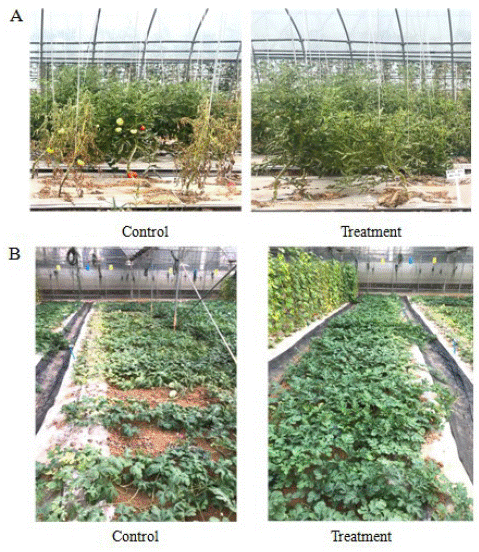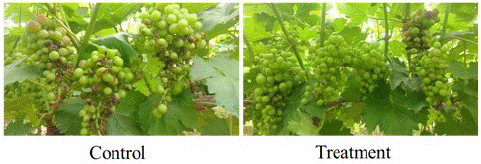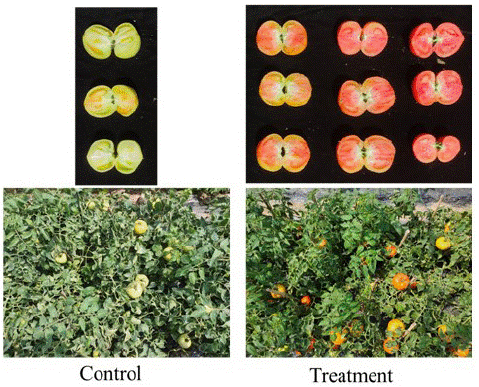
Special Article: Soil and Plant Analysis
Ann Agric Crop Sci. 2023; 8(4): 1139.
Soil Disturbing Agent-Creation and Application of “G15” Series Products
Jun Liu1-3; Siyi Deng1-3; Wei Chang1-3; Dazhao Yu1-3; Hua Wang1-3*
1Institute of Plant Protection and Soil Fertilizer, Hubei Academy of Agricultural Sciences, Wuhan, China
2Hubei Key Laboratory of Crop Disease, Insect Pests and Weeds Control, Wuhan, China
3Key Laboratory of Integrated Pest Management on Crops in Central China, Ministry of Agriculture, Wuhan, China
*Corresponding author: Hua Wang Institute of Plant Protection and Soil Fertilizer, Hubei Academy of Agricultural Sciences, Wuhan, China. Email: wangh@hbaas.com
Received: July 18, 2023 Accepted: August 21, 2023 Published: August 28, 2023
Short Commentary
Diseases caused by two or more soil-borne pathogens are called compound soil-borne diseases. We have pioneered the "root splitter" and the imaging analysis system, providing a new tool for studying compound soil-borne diseases and a new method for evaluating crop resistance and pesticide (fertilizer) efficacy, and laying a foundation for the development of microbial agents, pesticides, and fertilizers. On this basis, we have developed a range of soil-borne disease disturbance agents “G15”, including a series of bio-organic fertilizers, liquid fertilizers and immune inducers. a) Microecological control series of bio-organic fertilizer: a new method of strain culture and classification screening based on the information of main components of organic fertilizer materials was used to obtain strains with high matching degree with organic materials. Then the process optimization technology was renewed by the ferulic acid rapid detection system. Through the 2-hour rapid detection and 30-day rapid optimization, the qualification rate of products is over 95%. It also standardized the basic operation methods and application doses for different crops and different application methods, and stabilized the application effect of products. The application of bioorganic fertilizers significantly reduced the abundance of pathogenic fungi and bacteria in the soil, and significantly inhibited the development of Solanaceae and Cucurbits wilt in the field (Figure 1A & 1B). b) Liquid fertilizer series products: liquid fertilizer with large, medium and trace elements, including nanometer silicon, ionic boron, ionic calcium, macroelement water-soluble fertilizer etc, which can improve crop quality and yield, increase disease resistance. We found that nano-silicon, ionic boron and ionic calcium can significantly promote the growth and disease resistance of grape (Figure 2). c) Salicylic Acid (SA), an immune inducer product, can improve the microbiological structure of soil by flushing with basic fertilizer; Foliar spraying can promote the expression of crop resistance genes, enhance the ability of drought resistance, salt resistance, oxidation resistance and heavy metal resistance, and improve the stress resistance and disease resistance of crops; Soaking or spraying can store the harvested fruits and keep them fresh; Combined with liquid fertilizer series products, crops can be put on the market early. However, SA is a natural product widely used in the plant kingdom and has a wide range of regulatory effects on plant resistance and growth. SA is slightly soluble in water and easily soluble in ethanol, ether and chloroform, so the concentration of SA solution is currently limited and the highest concentration can reach only 8%. Therefore, the concentration of SA and a higher proportion of ethanol in the solution limit the wide use of SA solution. In this study, we added willow bark to an aqueous solution containing PH 2.0-3.5 and soaked it at room temperature under the action of ultrasound and electrostatic field, which promoted the dissolution of water-soluble components and inhibited the dissolution of SA. After filtering the aqueous solution, polyethylene glycol was added to increase the solubility of SA, and finally the SA solution with a concentration of more than 12% was obtained. In order to verify the effect of the high content of SA on improving crop yield and ripening. We applied the leaf spray method to immature tomatoes in the field. The results showed that the total weight of 30 tomatoes in the treatment group was 7.4 kg, while in the control group it was 5.55 kg, an increase of 32.97%. The tomatoes in the treatment group were red in a wide range and reached the level of natural ripeness, while the tomatoes in the control group were cyan in a wide range and were not yet ripe. In addition, the average sugar content of tomatoes in the treatment group was 7.33, while it was 5.85 in the control group (Figure 3). The results suggest that spraying with a highly concentrated SA solution before flowering and harvesting can increase the yield and sweetness of tomatoes, adjust the uniform ripening time of tomatoes, effectively reduce tomato cultivation obstacles and harvesting costs, and improve the benefits of cultivation. Therefore, in order to prevent and control the compound soil-borne diseases caused by multiple soil-borne pathogens, we proposed a combination of bio-organic fertilizers, liquid fertilizers with large, medium and trace elements and immune inducers to regulate the composition of soil microbial community, improve the soil ecological environment and promote crop growth to comprehensively control the compound soil-borne diseases.

Figure 1: Effect of G15 bio-organic fertilizer on controlling wilt of tomato and watermelon in field. (A) Effect of treating tomato in field; (B) Effect of treating watermelon in field; Control: untreated. Treatment: after G15 bio-organic fertilizer treatment.

Figure 2: G15 liquid fertilizer reduced the occurrence of grape diseases and promoted grape growth. Control: untreated. Treatment: after G15 liquid fertilizer treatment.

Figure 3: G15 immune inducer-12% Salicylic acid can increase the yield and sweetness of tomatoes, adjust the uniform ripening time of tomatoes. Control: untreated. Treatment: after G15 immune inducer treatment.
Author Statements
Funding
This work was supported by Key Technology Research and Demonstration Project of Hubei Agricultural Science and Technology Innovation Center (2020-620-000-002-07), Natural Science Foundation of Hubei Province (2022CFB852), and the Hubei Academy of Agricultural Sciences youth foundation (2023NKYJJ13). The funders had no role in study design, data collection and analysis, decision to publish, or preparation of the manuscript.